Emergency Water Damage Tips - Before Help Arrives
6/15/2020 (Permalink)
A household flood can be devastating and it’s easy to give in to panic. Take a deep breath, make sure everyone is doing ok and tackle what needs to be done one step at a time. Below are important things to do following a flood in your home:
- Shut off the water source. If you are able to do so safely, shut off the water source immediately or contact a qualified professional to stop the water source for you.
- Cut power to wet areas of building. If access to the main electrical panel is safe from electrical shock, turn off all breakers for wet areas of the building.
- Avoid unsafe areas. Do not enter any areas where electrical equipment, outlets, breakers or switches have been exposed to the water. Always keep away from anything that poses a threat of electrocution.
- Do not use your household vacuum to try to clean up the water. Our equipment is specially designed to suck up water where a regular vacuum is not and may lead to electrocution.
- Use caution with rooms that have wet ceilings and walls. Do not enter a room that has a ceiling sagging from retained water. Also, don’t turn on any light fixtures or fans that are in a wet ceiling or wall.
- Check that any vital medications are safe.
- Save any items of value/sentimental importance that are safe to get to and move them to a dry location.
- Place wood blocks or aluminum foil between furniture legs and wet carpet if you are able.
- Call for help. We are available 24/7 to assist with emergency restoration services. (800) 352-7251. The first 24 hours following a water loss are critical because being proactive helps in preventing secondary or permanent damage. Also contact your insurance carrier ASAP. Write down anything that is important (i.e. a claim number) to remember and keep that information handy.
- While you wait for help to arrive, remove as much access water as you are able by mopping and blotting.





 24/7 Emergency Service
24/7 Emergency Service
